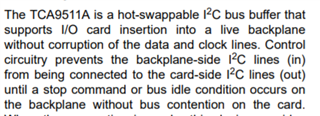Other Parts Discussed in Thread: TCA9511A, TCA9545A, SN74CB3Q3253, TCA4307, TCA9548A
Hi team,
My customers want to use SN74CBTLV3125 in below application.

They have below questions, need your kind answers.
1. Does SN74CBTLV3125 support this hotswap application? This post said yes. Could you please explain how SN74CBTLV3125 can support? Whether there's special design inside the device? We saw some devices like TCA9511A specifies hot-swappable, how can TCA9511A support hotswap?
2. We saw SN74CBTLV3125 abs voltage is only 4.6V, very small. It's kind of risky in our 3.3V application. What do you think?
3. If we insist to use SN74CBTLV3125, can we add external components like TVS or diode to implement hotswap? Could you please suggest some methods?



